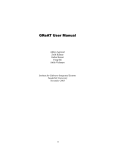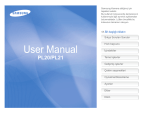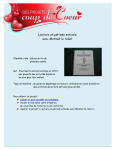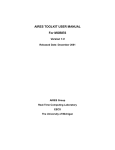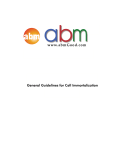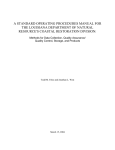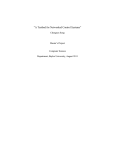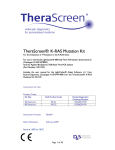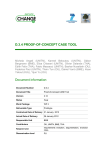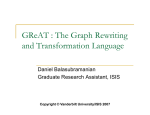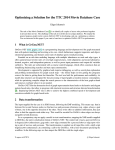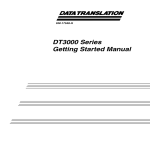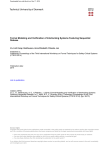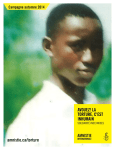Download A Subgraph Operator for Graph Transformation Languages
Transcript
Electronic Communications of the EASST
Volume X (2007)
Proceedings of the
Sixth International Workshop on
Graph Transformation and Visual Modeling Techniques
(GT-VMT 2007)
A Subgraph Operator for Graph Transformation Languages
Daniel Balasubramanian, Anantha Narayanan, Sandeep Neema,
Feng Shi, Ryan Thibodeaux, and Gabor Karsai
12 pages
Guest Editors: Karsten Ehrig, Holger Giese
Managing Editors: Tiziana Margaria, Julia Padberg, Gabriele Taentzer
ECEASST Home Page: http://www.easst.org/eceasst/
ISSN 1863-2122
ECEASST
A Subgraph Operator for Graph Transformation Languages
Daniel Balasubramanian, Anantha Narayanan, Sandeep Neema,
Feng Shi, Ryan Thibodeaux, and Gabor Karsai
Institute for Software-Integrated Systems
Vanderbilt University
Nashville, TN 37235, USA
Abstract: In practical applications of graph transformation techniques to model
transformations one often has the need for copying, deleting, or moving entire subgraphs that match a certain graph pattern. While this can be done using elementary
node and edge operations, the transformation is rather cumbersome to write. To
simplify the transformation, we have recently developed a novel approach that allows selecting subgraphs from the matched portion of the host graph, applying a
filter condition to the selection, and performing a delete, move, or copy operation
on the filtered result in the context of a transformation rule. The approach has been
implemented in the GReAT language and tested on examples that show the practical
efficacy of the technique. The paper describes the technique in detail and illustrates
its use on a real-life example.
Keywords: model transformations, graph transformations
1
Introduction
Practical model-driven software development necessitates software tools that transform models,
and these tools are often implemented using graph transformation principles. Graph transformation formalisms (e.g. single and double pushout [Roz97]) are based on node and edge matching,
followed by creation of new nodes and edges, and/or removal of matched nodes and edges. In
real-life applications, where the model transformations were implemented using graph transformation rules, we have observed the need for a more sophisticated operation that can move, delete,
or copy entire subgraphs after the match has been computed.
The specific problem can be described as follows. We have a graph transformation language
that supports graph rewriting rules; the left hand side of the rule is matched against a host
graph, and if the match is successful, then the actions specified by the right hand side are executed. These actions can include deleting and inserting new edges and nodes. We argue that
these elementary graph modification operations are often very low level, and practical users may
want to use more complex, subgraph-oriented operations. The problem is especially apparent in
graph transformation languages where the pattern nodes and edges could have cardinalities (like
GReAT [AKN+ 06]), resulting in multiple matches from one activation of a rule. In this case,
one has to create many simple rules to iterate over the results of the matching, as well as relating
elements of different matches: clearly a cumbersome and error prone task.
For example, consider a model that contains a graph of nodes that are connected in a simple
linear fashion, and some of the nodes have their ‘color’ attribute set to ‘red’ and some set to
1 / 12
Volume X (2007)
A Subgraph Operator for Graph Transformation Languages
‘green’. If we want to find all the ‘red’ nodes and the edges that connect them (but only them),
this can be done with a simple graph pattern. However, moving these ‘red’ nodes plus the edges
between them into a different model container while discarding any ‘red-green’ edges requires
a rather non-trivial sequence of operations (consisting of simple node and edge addition and
deletions).
Motivated by this and similar examples, we have developed an approach for specifying (‘selecting’) subgraphs from the result of the ‘match’ phase of the rule execution. These resulting
subgraphs can then be deleted, copied, or moved to a different part of the graph. We have implemented this feature in the context of the GReAT language. The paper revisits the GReAT
rule execution behavior, introduces the new ‘group’ concept and how it has extended the rule
execution mechanism, presents a detailed example, describes related results, and summarizes the
results and discusses potential research directions.
2
Background
The GReAT toolkit is an integrated environment for the specification and execution of model
transformations using graph transformation rules. The GReAT language is a graphical language
for specifying the transformation rules in terms of the meta-models of the source and target
languages. In this section, we will review the basics of the GReAT language.
2.1
The GReAT Language
The meta-models of the source and target languages of the transformation are specified using
UML class diagrams and added as packages in GReAT. In addition to this, GReAT allows users
to add additional packages to specify cross-domain links and temporary links using the UML
notation. Along with rule construction ingredients such as Blocks and Rules, these form the
core concepts of the GReAT language, which can be subdivided into the following three sublanguages:
• Pattern Specification Language
• Transformation Rule Language
• Sequencing and Control-Flow Language
Pattern Specification Language
The Pattern Specification Language is used to specify the graph pattern to be matched in the
host graph. The graph pattern consists of nodes and edges, which must correspond to classes
and associations from one of the existing packages. A pattern is a sub-graph in the host graph,
such as an association conn between two classes ClassA and ClassB contained in a class ClassC.
Figure 1 shows this pattern as seen in a GReAT rule. Such a pattern will match all associations
of type ‘conn’ between instances of classes ClassA and ClassB that are contained in a class of
type ClassC. A match binds the pattern variables classA, classB, and classC to three instances (of
the respective type) that satisfy the topological constraint expressed by the pattern. A condition
Proc. GT-VMT 2007
2 / 12
ECEASST
Figure 1: Example GReAT Rule
requiring the absence of a node or edge is called a negative application condition, and it is
specified by using a pattern cardinality of zero for the appropriate elements.
Transformation Rule Language
The basic transformation entity of a GReAT transformation is called a transformation rule. A
rule consists of a graph pattern specified using the pattern specification language and an action
on the pattern elements or newly created elements. Three types of actions are allowed: Bind,
specifying that the element is to be matched in the host graph; CreateNew, specifying that the
element should be newly created; and Delete, specifying that the element must be matched and
then deleted from the graph. The rule interacts with other rules in the transformation using
an Input Interface for receiving nodes matched in a previous rule and an Output Interface for
passing elements to the next rule. A boolean expression can be inserted as a Guard to enforce the
execution of a rule only under certain conditions. In addition, a special element called Attribute
Mapping can be added to supplement the rule with C++ code. The Attribute Mapping code can
be used to perform additional functions such as performing computations and setting the values
of attributes for the existing or newly created objects. Note that a rule may generate multiple
matches. For instance, if classC contains two instances of classA and two instances of classB,
with the appropriate pairs connected via separate instances of the ‘conn’ association, the pattern
matching yields two matches and the rule actions will be executed for each match. Each rule
can also be configured to be executed for one, randomly selected match or for all the possible
matches. Figure 1 shows an example GReAT rule with the input ports on the left and the output
ports on the right. The node Item is marked with the CreateNew action (indicated by the tick
mark on the bottom right), and the rest of the nodes are marked with Bind.
A transformation rule in GReAT is a composite structure that includes both the LHS and the
RHS of the transformation. In other words, elements that are marked with the Bind action can be
considered as the LHS of the rule, and other elements in the same pattern that are marked with
the CreateNew or Delete actions can be considered as the RHS. (Note that nodes to be deleted
3 / 12
Volume X (2007)
A Subgraph Operator for Graph Transformation Languages
are matched first.)
The basic unit on which a rule operates is called a packet, which consists of nodes of the
host graph to be bound to the input ports of the rule, one-to-one. When a rule fires, the pattern
matching algorithm finds the matching subgraphs in the host graph, depending on the pattern
specified in the rule. As mentioned above, a single rule execution may find multiple matches.
From our example, given a classC, there could be multiple classB and classA objects associated
via a conn, all being the children of the classC. Once these matches are found, the rule actions
are executed for each match. For each match and action execution output packets are generated
and placed at the output ports of the rule. The nodes bound to the output ports of the rule will
provide the output packet(s) of the rule, and that will subsequently function as the input packet(s)
of the next rule in the sequence of rules. In the case of the first rule, the nodes forming the input
packet are specified by the user.
Sequencing and Control Flow Language
The sequencing and control flow language allows users to compose a series of rules specified
using the transformation rule language. The sequencing allows users to connect multiple rules
in a sequence such that each rule is executed in the order determined by the direction of the
connections between the ports of the rules.
For the sake of convenience and manageability, rules can be composed in a hierarchy by
placing a set of rules in a Block or a ForBlock. When a sequence of rules is placed in a Block,
each rule processes all its input packets and then passes the produced set of output packets to
the next rule. In the case of a ForBlock, each input packet of the parent ForBlock passes through
all the rules before the next packet is processed. Blocks also allow recursion by connecting the
output of the last rule in the block to the input interface of the block.
Conditional execution of rules can be specified by using the Test and Case blocks. A Test
block contains multiple Case blocks, each specifying a desired match and a set of connected
output ports, but no CreateNew and Delete elements. The output(s) of the Cases are connected
to the output(s) of the parent Test. Each Case is tried, and the output produced by the successful
one is place on the output interface of the Test.
3
The Group Operator
As it was discussed in section 2, our current implementation for a graph re-writing rule’s execution works in two sequential steps:
• Step 1: Find all the valid matches in the host graph for the given pattern (i.e., match the
LHS of the rule in the host graph) and the given binding for the input ports.
• Step 2: For each match, independently, apply the rule action(s). This can include deleting
elements, creating new elements, and changing attributes.
The major limitation with this algorithm is the inability to apply a single rule action across
multiple matches. After all matches are computed, the rule’s action is executed individually
Proc. GT-VMT 2007
4 / 12
ECEASST
on each match; furthermore, there exists no mechanism by which one can access any information about other matches while processing a specific match. This can sometimes pose a severe
limitation to the types of transformations one can write.
For instance, the user may need the ability to operate on an entire subgraph (composed from
multiple matches) as a whole rather than on individual elements. If this subgraph may contain an
arbitrary number of elements, then the graph pattern cannot be specified as a simple rule. What
is needed is a way to find smaller pieces of the subgraph, and then combine these pieces to form
the entire subgraph. In terms of GReAT this means we need a way to combine multiple matches
of a rule, and then perform the rule’s action on these combined matches.
To achieve this capability, we had to extend the existing GReAT language. The solution was
the introduction of a new syntactic element known as a ’Group’ into the language. A single
Group element can be inserted into any rule, which allows the user to select an arbitrary set of
pattern elements from that rule. A Group element is associated with a set of rule elements (pattern
nodes and edges), but the only action allowed on these elements is Bind. The elements in this set
are then used to form the subgraphs mentioned in the previous paragraph. It is important to note
that the introduction of a Group element into a rule does not affect the pre-existing semantics of
pattern matching in any way; that is, the set of matches found by a rule is the same regardless
of whether or not that rule contains a Group element. A Group affects the semantics of a rule
only after the pattern matching phase of that rule’s execution, at which point the Group is used
to specify how to form the set of subgraphs (also called subgroups to emphasize the relationship
with the Group element). The user has the ability to control the way in which matched elements
are added to the subgroups by specifying ’filtering criteria’ for the Group that determine whether
a matched element should be added to a subgroup or not. After all subgroups have been formed,
then normal rule execution proceeds, with the exception that actions are performed for each
subgroup (instead of for each match per the default behavior).
The precise semantics of a transformation rule that contains a Group element are informally
described below:
• Step 1: Find all the valid matches in the host graph for the given pattern and given bindings.
A match contains one matched element from the host graph for each pattern element.
• Step 2: After all the matches are found, insert a subset of the matched elements into a
single subgroup based on the user specified criteria. These criteria are boolean expressions
that compare matched elements of the current match to elements already inserted into
subgroups; if the expressions evaluate to true, then the matched elements are inserted into
the subgroup against which the expressions were evaluated. If the expressions evaluate
to false for all existing subgroups, then the matched elements are inserted into a newly
created subgroup.
• Step 3: Iterating over the subgroups, for each subgroup, execute the regular rule actions.
Note that these actions apply to rule elements that are not part of the Group, and they include actions like creating new elements, and changing attributes. Matched (non-grouped)
elements that are slated for deletion are removed at this time as well.
• Step 4: For each subgroup, apply the group action. This can be any of the following:
5 / 12
Volume X (2007)
A Subgraph Operator for Graph Transformation Languages
Figure 2: Signal Flow Model
– Bind: No action will be taken on any of the objects in the subgroup.
– Move: All of the objects in the subgroup will be moved into a single container: a
node that has a ’containment’ relationship with the Group expressed in the rule. If
this container is found via the matching process, then it must be a unique node. If
this container is newly created, then it is unique (per Step 3). Edges whose endpoints
are in different subgroups (or one of them is outside of all subgroups) are removed.
– Copy: All objects of the subgroup will be copied into all containers that have a ’containment’ relationship with the Group expressed in the rule. Edges whose endpoints
are in different subgroups (or one of them is outside of all subgroups) are removed.
– Delete: All objects in the subgroup will be deleted.
Steps 3 and 4 describe how the introduction of the group operator gives the ability to apply a
single rule action across multiple matches. Further, step 4 describes two abilities that were not
present in GReAT before the introduction of the Group operator: the ability to copy or move
entire subgraphs. While this moving and copying ability is trivial in the case that only a single
object is moved or copied, moving an entire subgraph, which includes a number of nodes and
edges, is a non-trivial task and requires the use of a group-like operator. This is especially true if
one does not know a priori the number of elements that will have to be moved.
The next section describes an example of the Group operator in a transformation.
4
Example of the Group Operator
This example, drawn from the domain of signal processing, demonstrates how to use the Group
operator in a transformation. Suppose we have a signal flow chain with five primitive components, as shown in Figure 2.
Each primitive component has a numeric Id associated with it. We assume that the components
PC0, PC1, and PC2 have an Id of 0, while components PC3 and PC4 have an Id of 1. The
user wishes to write a transformation that will disconnect the components according to their
Id number and put each group of connected components in its own newly created compound
component; components with the same Id should be moved to the same compound component,
and the existing connections between them should be preserved. In our case, the result of the
transformation applied to the example model shown in Figure 2 should be composed of two new
compound components that contain the signal flow components as shown in Figure 3.
Proc. GT-VMT 2007
6 / 12
ECEASST
Figure 3: Resulting Model
Figure 4: Group Rule
Figure 4 shows a GReAT transformation rule with a Group element that will accomplish this
transformation. The incoming context for this rule is the compound component in which the
signal flow chain is found. Figure 5 shows this transformation rule using a special visualization,
highlighting only those elements that belong to the Group (PC1, PC2 and Signal). As can be
seen in the rule shown in Figure 5, the Group element contains three elements: two primitive
components and the association class Signal. The action of the Group is “move”, meaning that
objects bound to pattern variables contained in the Group (i.e., PC1, PC2, and Signal) are moved
to the Compound Component “newCC”. The execution order of the rule is:
• Step 1: Pattern matching. Find all matches for the pattern described in the rule and apply
the Guard to discard matches in which two primitive components with different Id-s are
bound to PC1 and PC2. The code in the Guard is:
return (PC1.Id()==PC2.Id());
This ensures that only matches consisting of two connected primitive components with the
same Id will be considered. For the input model shown in figure 2, the matches are:
7 / 12
Volume X (2007)
A Subgraph Operator for Graph Transformation Languages
Figure 5: Group Rule visualized in Set Mode
{(PC0, PC1), (PC1, PC2), (PC3, PC4)}
• Step 2: Form the subgroups. Host graph elements that are part of the same match will all
be inserted into the same subgroup, and the subgroups are formed using the user specified
grouping criteria. The grouping criteria code for our example above is the following:
return (the_PC1.Id()==other_PC2.Id());
This code is an attribute of the Group and works as follows. PC1 and PC2 are prefixed
with “the ” and “other ”, respectively. These special prefixes give the ability to compare
model elements that are part of different matches. The “the ” prefix refers to a graph
element (bound to a pattern element) found in the current match that is being considered
for insertion into a subgroup, while the “other ” prefix refers to graph elements that are
already contained in a subgroup. In our example, the code returns true (and results in
the insertion of the graph elements from Groups of two different matches into the same
subgroup) if the Id of primitive PC1 in one match is the same as the Id of the primitive
PC2 in a different match. The two subgroups formed in our example will be:
Group 1: PC0, PC1, PC2 (and the connections between them)
Group 2: PC3, PC4 (and the connections between them)
• Step 3: Apply the regular rule action, which in our example is the creation of new objects.
After the subgroups are formed in step 2, a new CompoundComponent object is created
for each subgroup.
• Step 4: Perform the Group action on each subgroup, which in our example is to move
the subgroups. The constituent parts of the subgroups, assigned in Step 2, are moved
Proc. GT-VMT 2007
8 / 12
ECEASST
into the newly created CompoundComponent from Step 3. Note that the edge that did
exist between PC2 and PC3 is deleted due to the fact that those two pattern classes were
inserted into different subgroups.
5
Group Implementation
Using a Group in a transformation rule requires that the rule
1. specifies the Group and the elements it contains,
2. specifies the grouping criteria for the matches, and
3. specifies the action to be performed on the Group.
We have implemented Groups using the Set concept of GME [GME]. A Set is a universal
container that can hold any number of arbitrary elements. In this manner, a Group can contain
any type and number of pattern nodes and edges normally found in a transformation rule. The
visualization interface of GME allows the user to specify which pattern classes are part of the
Group without drawing any explicit edges or associations (see previous figure).
In addition to specifying which elements of a rule belong to the Group, one must also specify
the grouping criteria, which determine the subgroup into which each match should be placed.
These criteria are written as boolean expressions that evaluate to either true or false, and are
added as an attribute to the Group element. The expressions are used to compare each match
to matches that have already been placed into a subgroup; if the expressions evaluate to true,
then the current match is added to the subgroup against which the criteria were evaluated. If the
expressions evaluate to false for all existing subgroups, then the current match is inserted into
a newly created subgroup. The elements of two distinct matches are identified in the grouping
criteria by prefixing “the ” and “other ” to the class names of the elements. For instance, to place
all instances of ClassA that have the same InvoiceNumber into one Group, the expression would
be: the ClassA.InvoiceNumber() = other ClassA.InvoiceNumber().
It should be noted that the distinct pattern matches may share common elements, and it could
happen that the grouping criteria allow the insertion of the same element into two different subgroups. As this could lead to erroneous rule execution, we believe this is an error that should
result in raising exception. We are currently investigating how exception handling could be incorporated into the language.
Once the Group has been completely specified, the action for the Group can be set to Bind,
Move, Copy, or Delete by selecting the desired value for the GroupAction attribute. The effect
of these actions was described earlier in section 3.
Currently, Groups have been fully implemented in the GR-Engine [AKN+ 06], our interpreter
for performing model transformations, and we have a prototype implementation in our code generator. The previous version of the GR-Engine had an architecture as shown in Figure 6, except
without the Group Manager module. Because of the loose coupling between the Pattern Matcher
and the Effector, implementing Groups primarily consisted of inserting a ‘Group Manager’ module between the two and defining the appropriate interfaces between the modules.
In the case that a rule contains a Group, the GR-Engine functions in the following manner:
9 / 12
Volume X (2007)
A Subgraph Operator for Graph Transformation Languages
Figure 6: Modified GR-Engine Architecture
• The Pattern Matcher functions exactly as before, finding all valid matches. After all
matches are found, they are passed to the Group Manager.
• Using the grouping criteria given by the user, the Group Manager forms the set of subgroups. After all subgroups are formed, they are passed to the Effector using a newly
defined interface created to handle subgroups.
• For each subgroup, the Effector first performs the regular rule action and then performs
the Group action (as previously described).
6
Related Work
Transformations on hierarchical subgraphs have been approached previously by Hoffman and
then Janssens. Hoffman [DHP02] introduced transformations on subgraphs by delimiting the
subgraphs with frames in which edges do not cross between frame boundaries. The copying
of subgraphs within this context permits copying only the nodes and edges contained within a
frame. The Group operator uses a similar idea for specifying membership; however, it allows for
restricting node membership in a Group by having the user select specific nodes and associations
within the subgraph using the set utility of GME. Only those selected nodes and associations
(between the selected nodes) will have the Group action (bind, move, copy, or delete) performed
on them.
Janssens [GSJ06] further generalized the copying of subgraphs by introducing two concepts
known as “copy” and “oncopy” within the MotMot project [SG05]. MotMot generates code for
templatized graph transformation rules created in the UML profile for Story Driven Modeling
(SDM) [SGJ05]. The “copy” and “onCopy” constructs allow for copying specific nodes and
Proc. GT-VMT 2007
10 / 12
ECEASST
edges in the same way the Group operator does; however, we believe, the Group operator’s
membership criteria allow for more selectivity in the GReAT implementation than in MotMot.
It is also worthwhile to mention the concept of amalgamated graph transformations presented
by Ehrig et al. in [BFH87] and utilized in the Algebraic Graph Grammar system (AGG) [TB93].
Amalgamated graph transformations decompose transformations into simpler graph productions
that can be performed in parallel and the results combined synchronously. The synchronous
combination restriction follows from the sharing of graph objects between the productions, i.e.,
actions performed on the results must be done such that conflicting or duplicate actions are not
performed on the same object. Currently, our Group operator does not automatically detect
whether or not a single element is part of two different subgroups. In the case that an element
does belong to two distinct subgroups, then the transformation is non-deterministic if the subgroups are moved to different containers. Otherwise, in the case that the subgroups are simply
copied, deleted, or bound, the result is deterministic. Ensuring that the subgroups do not contain
common elements is an area in which we are currently working.
Concerning the capabilities of other transformation tools, it seems those that use textual frameworks as part of their back-end have more ease and expressive power for implementing complex
transformations in their pattern/rule specifications. Most likely, tools such as ATL [ATL] or
VIATRA2 [VIA] could implement a feature similar to our Group operator more easily with
their textual transformation languages instead of implementing a graphical artifact interpreted
by transformation engines.
7
Summary and Future Work
We have introduced a technique for specifying arbitrary subgraphs in graph transformation rules
that allows the handling of such subgraphs as a unit to be moved, copied, and deleted. We have
implemented this new extension in the GReAT language and have tested it on several examples.
The current implementation is available only in the interpreted mode, but we started working on
the code generator that compiles such rules into executable code. We believe the technique is
fairly efficient and allows the compact description of complex graph operations.
There are several potential interesting research topics that arise from the initial idea. One is
related to code generation: how to generate efficient code that computes the Groups and performs
the necessary graph operations on the subgraph? Another direction is related to treating the
Groups as ”the” result of pattern matching and passing it to subsequent rules (note that Groups
essentially combine results from multiple matches). A third direction could be a more compact
specification of the Groups with node and edge types that are ‘generic’ (i.e. not of a specific
node or edge type). We plan to investigate these directions in the near future.
Acknowledgements: The research described in this paper has been supported by a grant from
NSF/CSR-EHS, titled ”Software Composition for Embedded Systems using Graph Transformations”, award number CNS-0509098, and by NSF/ITR, titled ”Foundations of Hybrid and
Embedded Software Systems”, award number CCR-0225610.
11 / 12
Volume X (2007)
A Subgraph Operator for Graph Transformation Languages
Bibliography
[AKN+ 06] A. Agrawal, G. Karsai, S. Neema, F. Shi, A. Vizhanyo. The Design of a Language
for Model Transformations. Journal on Software and System Modeling 5(3), Sept.
2006.
[ATL]
ATL Project. An ECLIPSE GMT Subproject.
http://www.eclipse.org/m2m/atl/
[BFH87]
P. Boehm, H.-R. Fonio, A. Habel. Amalgamation of graph transformations: a synchronization mechanism. J. Comput. Syst. Sci. 34(2-3):377–408, 1987.
[DHP02]
F. Drewes, B. Hoffmann, D. Plump. Hierarchical Graph Transformation. Journal of
Computer and System Sciences 64:249–283, 2002.
[GME]
GME 6 User’s Manual.
http://www.isis.vanderbilt.edu/Projects/gme/
[GSJ06]
P. V. Gorp, H. Schippers, D. Jannsens. Copying Subgraphs within Model Repositories. In 5th International Workshop on Graph Transformation and Visual Modeling
Techniques (GT-VMT). Vienna, Austria., 2006.
[Roz97]
G. Rozenburg. Handbook of Graph Grammars and Computing by Graph Transformation. World Scientific, 1997.
[SG05]
O. M. H. Schippers, P. V. Gorp. Model Driven, Template Based, Model Transformer
(MoTMoT). 2005.
http://motmot.sourceforge.net/
[SGJ05]
H. Schippers, P. V. Gorp, D. Janssens. Leveraging UML Profiles to Generate Plugins
From Visual Model Transformations. Electr. Notes Theor. Comput. Sci. 127(3):5–16,
2005.
[TB93]
G. Taentzer, M. Beyer. Amalgamated Graph Transformations and Their Use for
Specifying AGG - an Algebraic Graph Grammar System. In Dagstuhl Seminar on
Graph Transformations in Computer Science. Pp. 380–394. 1993.
[VIA]
VIATRA2 Framework. An ECLIPSE GMT Subproject.
http://www.eclsipse.org/gmt
Proc. GT-VMT 2007
12 / 12













